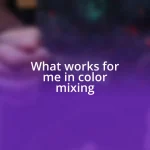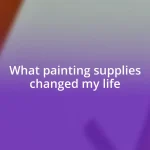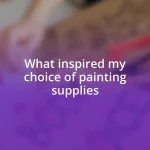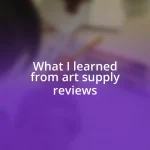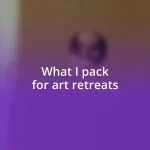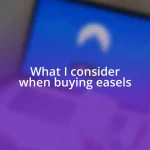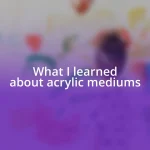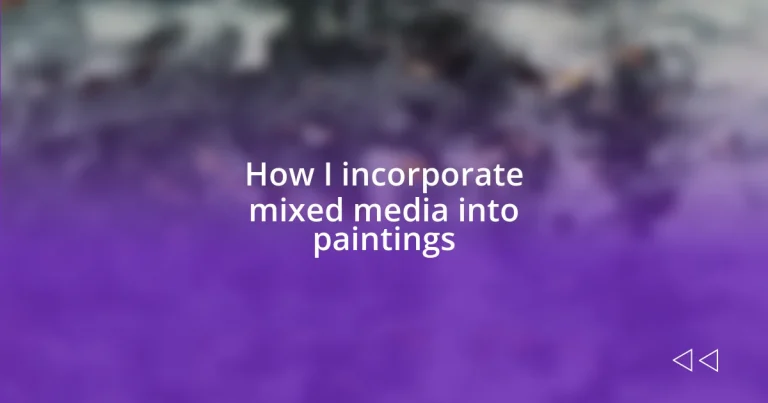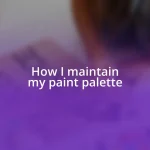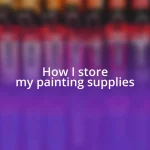Key takeaways:
- Mixed media painting allows for the integration of various materials, enhancing emotional depth and viewer interaction through texture and layering.
- Choosing the right materials can significantly transform the mood and narrative of artwork, with a focus on the emotional connections these materials evoke.
- Showcasing mixed media art effectively through lighting and framing can create immersive experiences that encourage viewer engagement and deeper connections with the artwork.
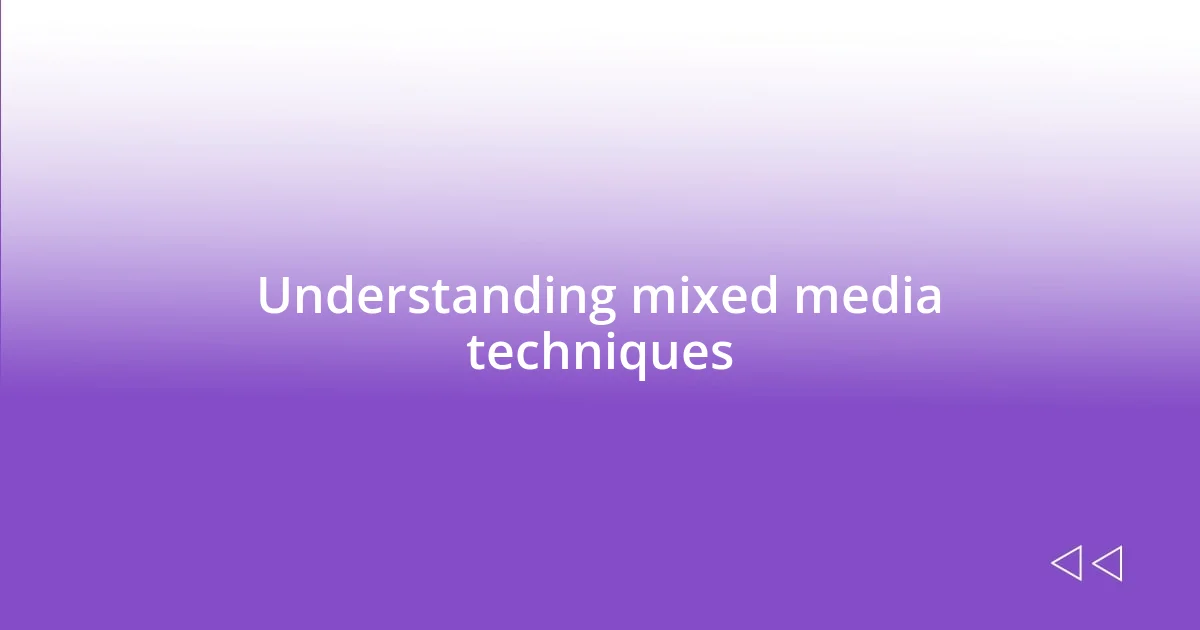
Understanding mixed media techniques
When I first stumbled upon mixed media painting, it felt like a breath of fresh air. The beauty lies in its versatility; the ability to combine various materials like acrylics, pastels, and even textiles opens up endless creative possibilities. Have you ever thought about how layering different textures can evoke different emotions in your artwork? That’s the heart of mixed media.
One technique that really captures my imagination is the use of collage within the painting. I remember a piece I worked on that integrated old newspaper clippings and colorful scraps of paper. As I layered these elements, I found a story emerging that was so much deeper than the paint alone could convey. It was as if each component spoke to one another, creating a rich dialogue on the canvas. Isn’t it wonderful how a simple cut-out can breathe life into a painting?
I also love experimenting with unconventional materials, like sand or fabric, to build dimension. One time, I added some textured fabric to a beach scene, which not only highlighted the waves but also provided a tactile experience that transformed the painting entirely. Have you ever thought about how our choices of materials can change the viewer’s interaction with art? It’s a fascinating aspect of mixed media that continually inspires me to push my boundaries.
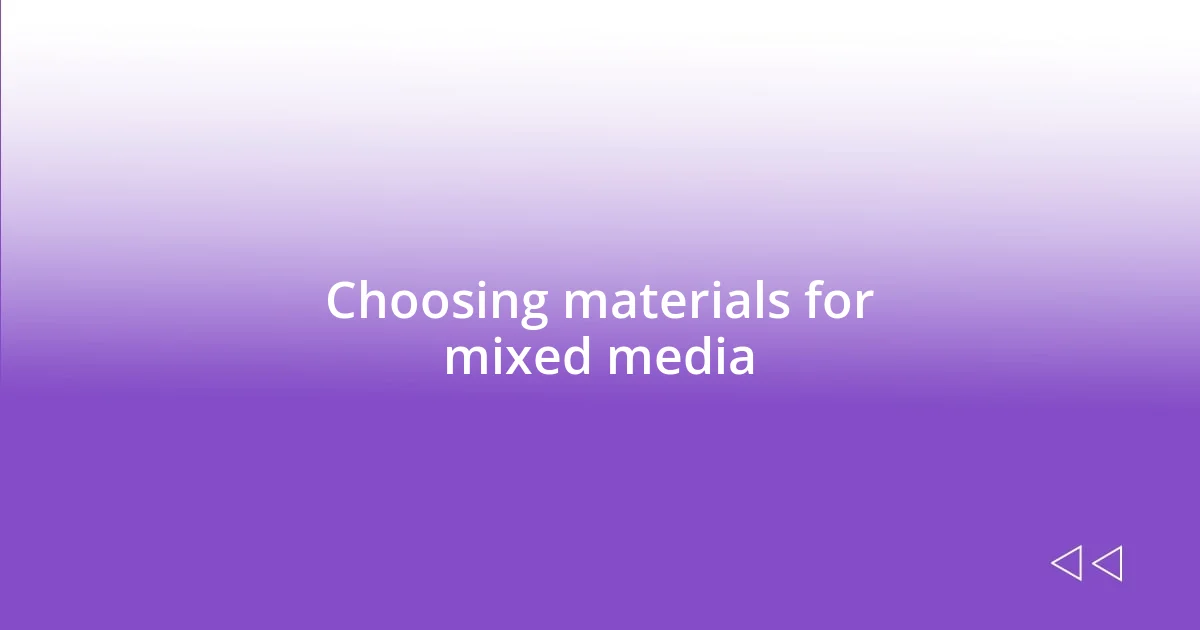
Choosing materials for mixed media
Choosing the right materials for mixed media can be a delightful puzzle. From my experience, I’ve found that the combinations I choose can radically alter the mood of a piece. For instance, using translucent papers can add lightness and depth, transforming a simple painting into a dreamy landscape. Have you ever played with materials that just click together on the canvas?
One time, I decided to incorporate metal leaf alongside vibrant paints. The contrasting reflection of the gold against a textured blue background created a stunning visual effect. It was like witnessing a sunrise on a cold winter morning—each layer revealed something unexpected. This interplay of materials brought an energy to my artwork that I hadn’t anticipated. What materials have you experimented with that brought about an unexpected change in your work?
Exploring the emotional connections of different materials has always intrigued me. When I choose weathered wood or rusty metal, it invokes feelings of nostalgia and history in my work. Similarly, soft fabrics can evoke comfort and warmth, inviting viewers to connect more intimately with the piece. How do your material choices resonate with the themes you explore in your art?
| Material | Effect |
|---|---|
| Acrylics | Vibrant colors, quick drying |
| Textiles | Tactile dimension, warmth |
| Paper | Adds layering, lightness |
| Wood | Natural texture, nostalgia |
| Metal Leaf | Reflective quality, luxury |
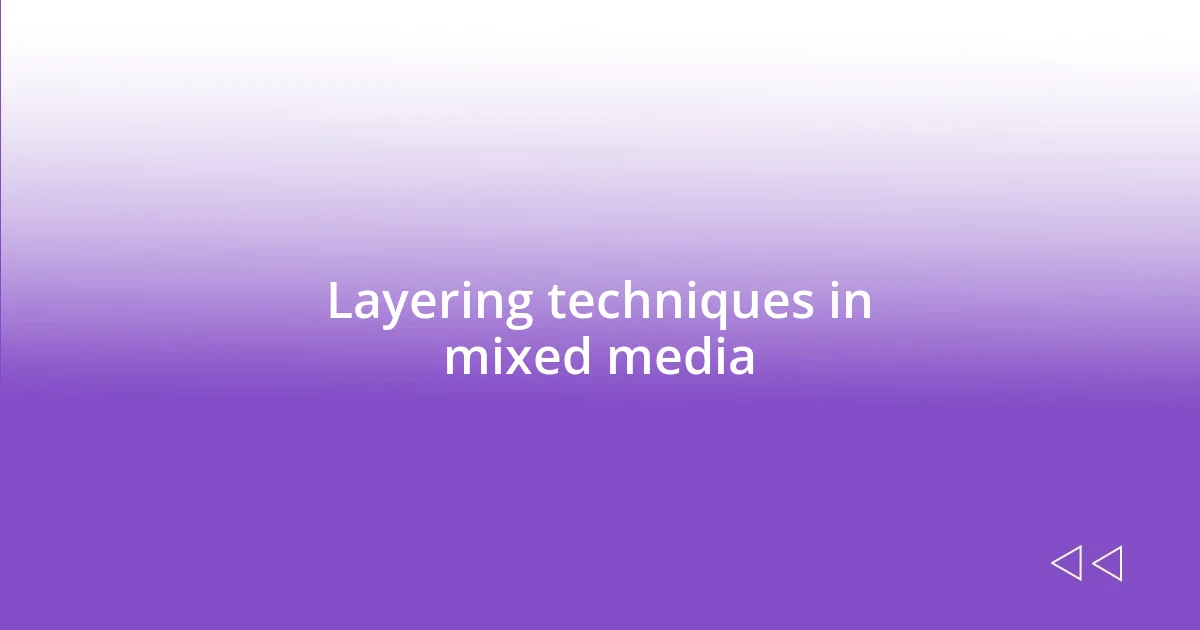
Layering techniques in mixed media
Layering techniques in mixed media are where the magic truly happens. I often think of layering as building a community within my artwork. Each layer contributes its unique voice, and together, they create a melody that resonates with the viewer. For example, during one project, I used clear varnish over a vibrant acrylic layer, which made the colors pop like morning sunlight breaking through clouds. It was a simple decision, yet it added an unexpected luminosity that made my heart race every time I looked at it.
Some effective layering techniques I’ve discovered include:
– Building with Gesso: Using gesso not just as a primer but as an artistic element creates an excellent base for layering.
– Transparent Overlays: Adding transparent materials like deli paper can create depth without obscuring the layers beneath.
– Texture with Modeling Paste: Mixing modeling paste into layers adds dimension—I’ve often found it transforms a flat surface into a tactile experience.
– Glazing: Applying thin layers of transparent acrylic can alter the shade beneath, lending a beautiful, ethereal quality.
– Mixed Textures: Combining hard and soft materials in layers, like glass pieces with fabric, can evoke contrasting emotions, inviting viewers to engage more thoughtfully.
Each layer unveils a personal journey, transforming the canvas into a reflective space that speaks to my experiences. Last week, while working on a piece featuring muted browns and greens, I placed a layer of textured paper between the paint layers. When I stepped back, it was as if I had trapped a memory within the painting, forever capturing that enchanting moment in nature. It’s an incredible feeling to see how layering can bring emotional depth and history to my works, inviting the viewer to explore and unravel their own stories while looking at my art.
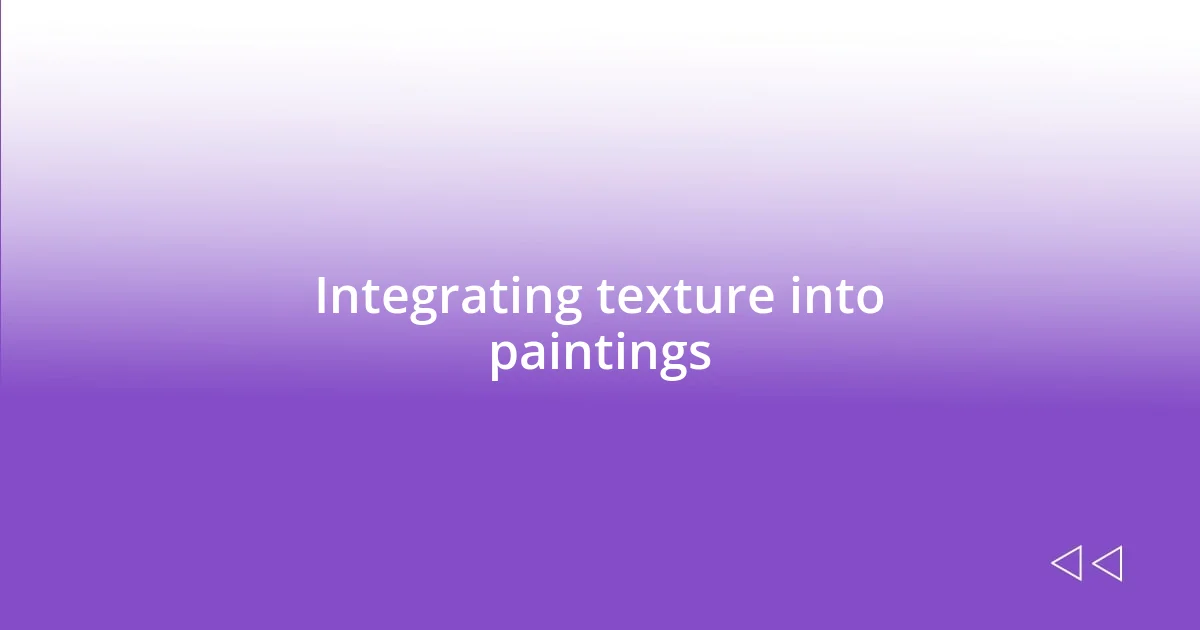
Integrating texture into paintings
Integrating texture into paintings is one of my favorite explorations in mixed media. I find that adding physical dimension often transforms the viewer’s interaction with the art. For example, I once decided to use coarse sand mixed into my paint for a beach scene. The rough surface mimicked the grit of sand underfoot, instantly transporting me back to sandy shores. Have you ever touched a painting that felt like it could pull you into a different world?
I’ve discovered that using unexpected materials enhances both the visual appeal and emotional resonance of a piece. In my last project, I integrated fabric remnants, like lace and burlap, into a floral composition. The juxtaposition of soft and rough textures created a harmonious balance, almost like the relationship between fragility and strength in nature. It reminded me how different elements can tell a story; can you think of a moment where texture elevated the narrative of your artwork?
Texture also invites viewers to engage physically with the painting. I remember making a piece with thick layers of modeling paste that created pronounced ridges. When someone grazed their fingers over it, the surprise in their eyes was priceless; they were connected to the artwork in a way beyond just visual appreciation. Have you ever seen someone get lost in the texture of your art, revealing a deeper connection to your work? It’s a delightful reminder that art is about shared experiences.
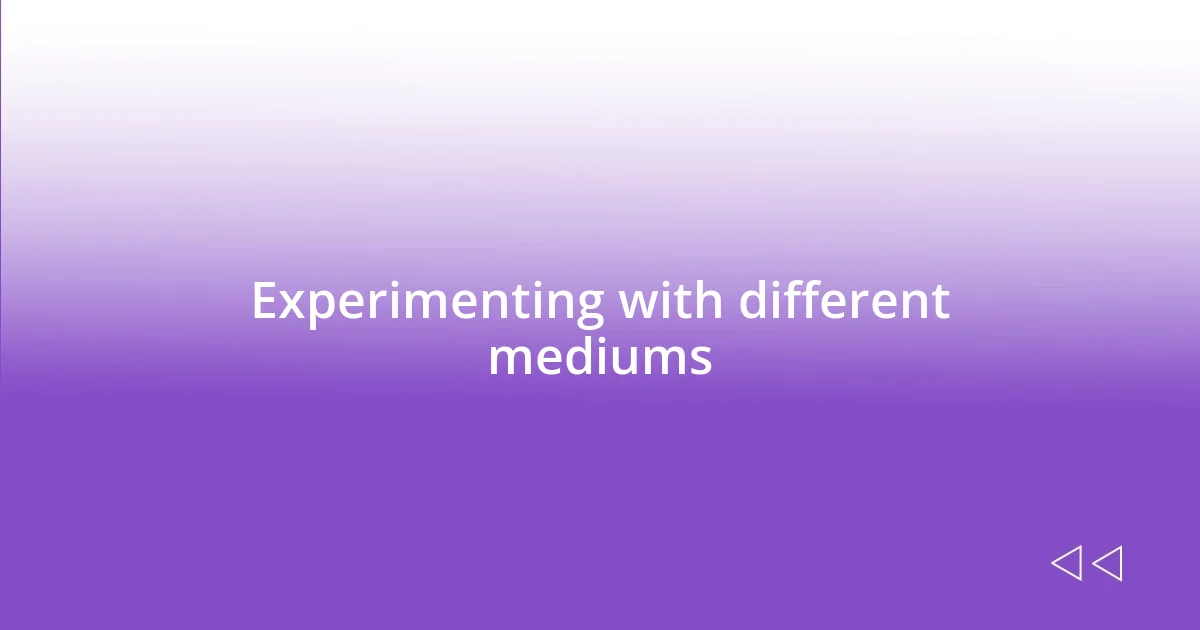
Experimenting with different mediums
Experimenting with different mediums can be a thrilling journey that pushes the boundaries of my creativity. I often find myself drawn to unconventional materials—like using coffee grounds sprinkled within a wash of watercolor to evoke a rustic, rich texture. It’s fascinating how something as simple as coffee can infuse not just texture but also a warm, inviting aroma that enhances the sensory experience of the piece. Have you ever used a material in a way that transformed not just the look, but the feel of your work?
In my recent exploration, I stumbled upon the potential of incorporating metallic threads alongside traditional paint. I wove thin strips of metallic fabric into a painted landscape, and the result was captivating. The light danced off the threads, creating shimmering effects that changed with the viewer’s angle, like the flicker of sunlight on water. I remember standing back and marveling at how these mixed elements made the artwork not just a visual delight, but almost a living entity. What surprising materials have you tried that elevated your art in unexpected ways?
I’ve also embraced the spontaneity that comes with mixing mediums. Recently, I dived into using found objects, such as bottle caps or feathers, as focal points in an abstract piece. I glued them onto the canvas, and they created a playful dialogue among the colors and forms. I couldn’t help but smile when I saw how they engaged viewers, prompting them to examine each piece closely, almost like piecing together a puzzle. Have you experienced that joy when unconventional elements breathe new life into your creations? It’s these moments of unexpected delight that keep my artistic journey vibrant and full of discovery.
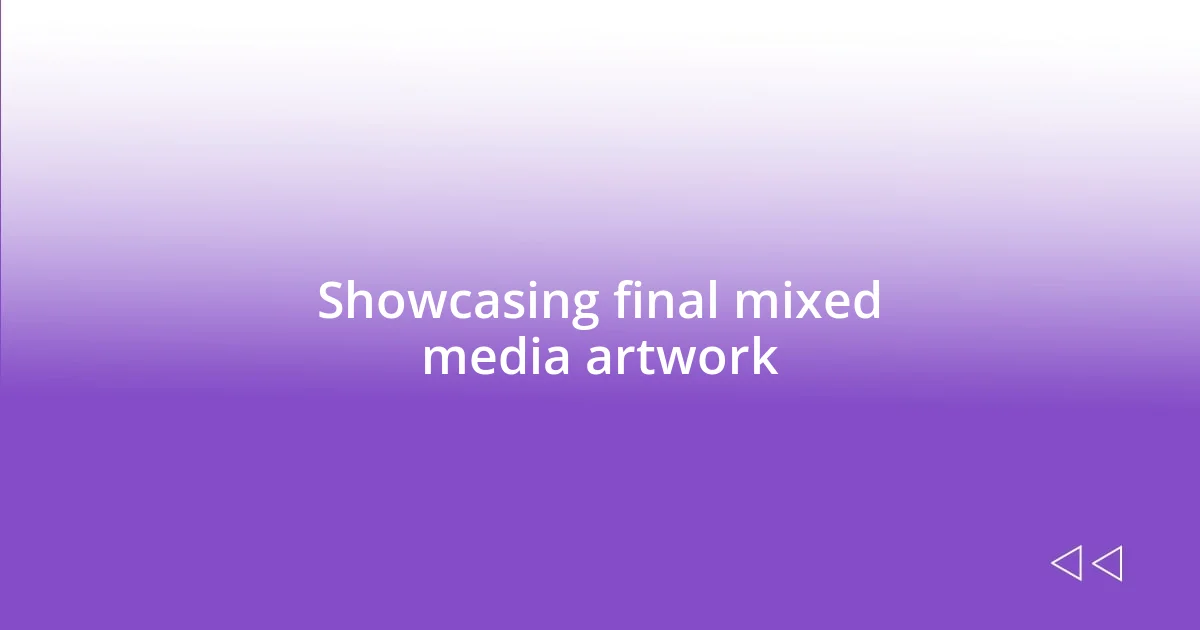
Showcasing final mixed media artwork
I often find that showcasing my final mixed media artwork is as important as the creation process itself. Each piece has its own personality, and I love displaying them in a way that accentuates their unique elements. For instance, I once hung a vibrant collage in a sunlit corner of my studio, allowing the interplay of light with the various textures to create a dynamic viewing experience. Isn’t it fascinating how the right lighting can change the entire mood of a piece?
I’ve learned that framing can play a significant role in how my mixed media art is perceived. For a piece that featured layers of painted paper and fabric, I chose a shadow box frame. This not only highlighted the dimensionality but also invited viewers to peer in, creating a sense of intimacy with the artwork. It’s gratifying when someone approaches that piece, captivated, and I can’t help but think—how many stories do these layers hold for them?
When I display my work at local galleries, I often create an immersive space that encourages interaction. I once set up a small area where people could touch swatches similar to those I incorporated into my artwork, making it a sensory experience. Seeing their intrigued reactions reminds me that art isn’t meant to be isolated; it thrives in shared moments. Have you ever thought about how much more powerful an art piece can become when it invites others to connect on a deeper level? It’s a joy to witness that spark of understanding and engagement unfold.
